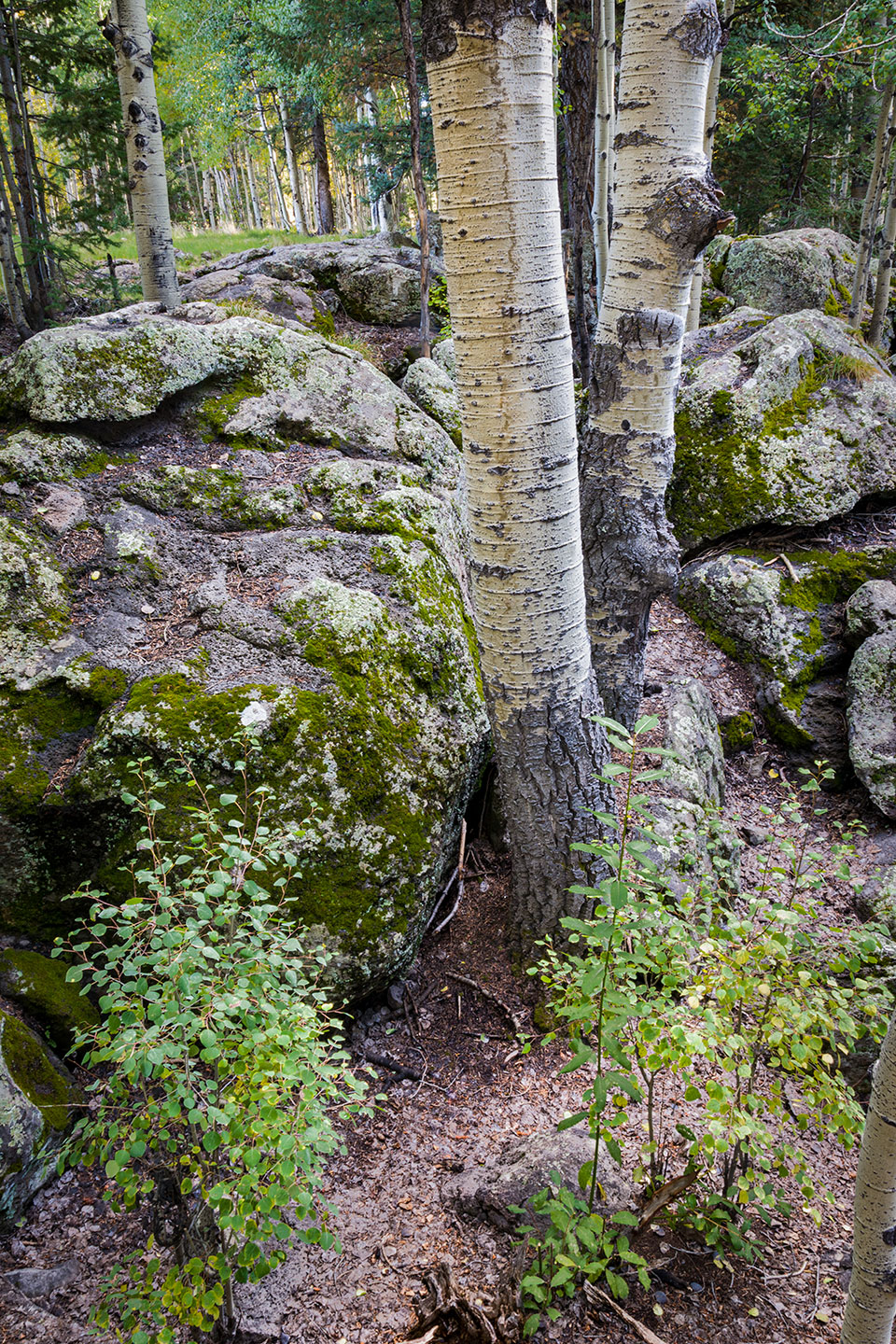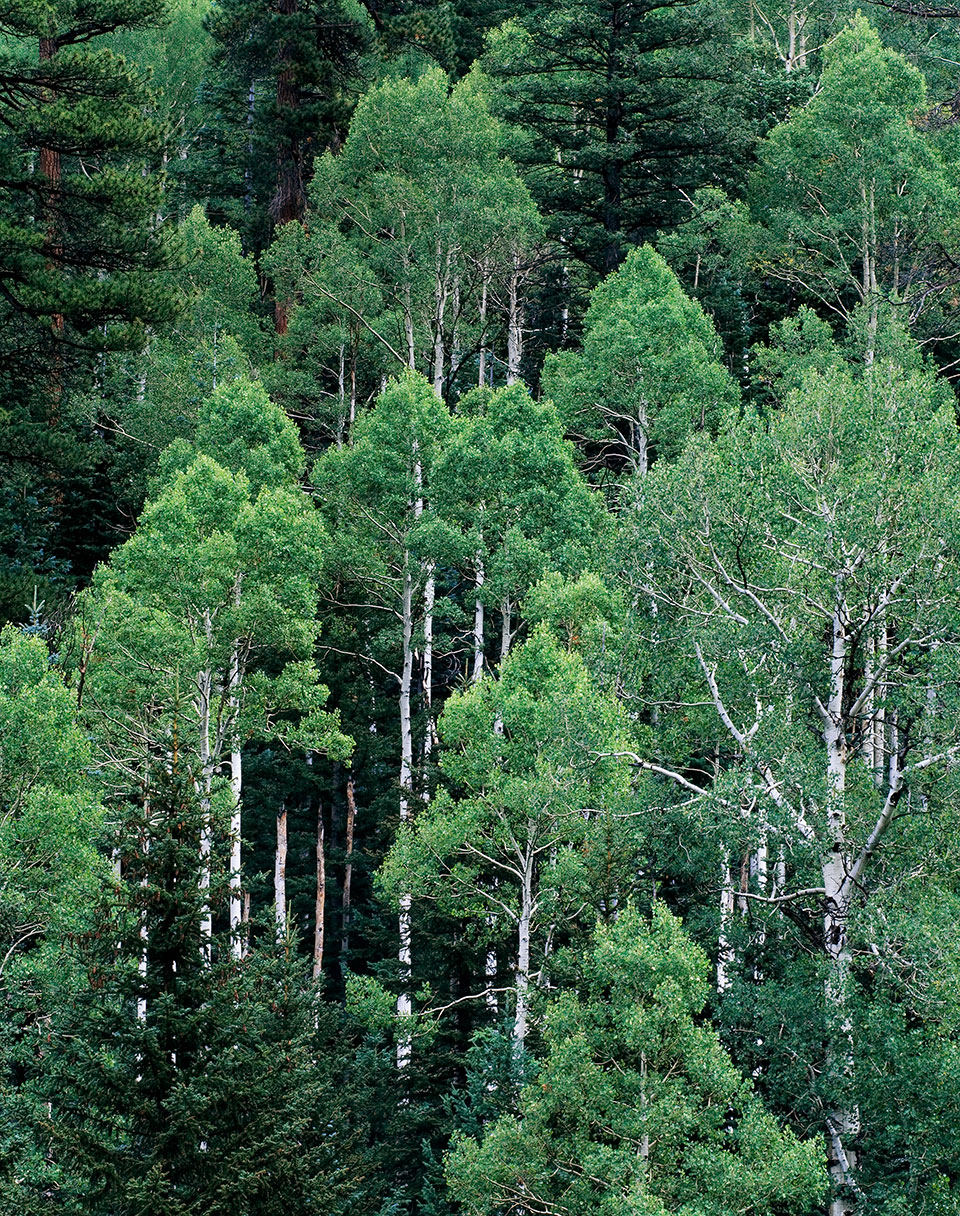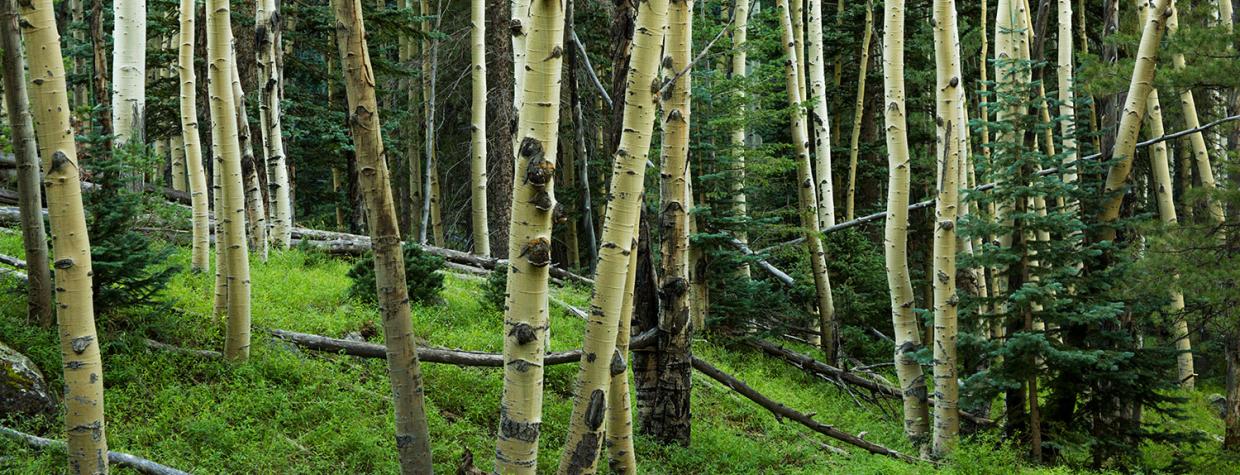This morning, I walked through a grove of winter aspens. Bare branches offered no shimmering summer green, no quivering, iridescent autumn gold. But no season can remove the trees’ dark eyes. Framed by arching eyebrows, communicative as the eyebrows on a human face, the aspens’ eyes are always watching. Are the trees waiting for some sort of word? What word will satisfy a tree? I’ve been reading a lot, lately, about how trees communicate. Nowhere, though, has anyone mentioned the eyes of aspens or presented the aspens’ view of the world surrounding them. Held by the eyes of the largest tree, I asked it what I should write.
The story of insistence, the aspen told me.
Insistence, because these trees are pioneers, the first to regenerate after a burn. They are survivors, opportunists. They are very, very old. They are also among the most widespread trees in North America, growing across much of Alaska and Canada, into New England and the Midwest, along the Rockies and the Sierras, and south into Mexico and, of course, Arizona. Because they’re native to northern and montane forests, aspens climb to increasingly higher altitudes on their trip south. Arizona has a lot of land at high altitude.

These are the oldest and largest of trees, although accepting this means letting go of the idea that seeing is believing. What we see are the slender white trunks of trees growing in groves where they have access to the sun. (For this reason, they are the first trees to re-establish after a burn, when the newly cleared forest allows them the sun they need.) But what seems a single tree is one part of a much larger organism whose main life force spreads underground in an extensive root system. Growing horizontally rather than vertically, the root system stores starches and proteins that enable the plants to survive harsh conditions. In a single stand of aspens, each tree is a genetic replica of every other tree — a clone. The stand itself is called a clone, too. All the trees of a clone leaf out in spring, and change color in autumn, at the same time. Every clone has its own timing — and, in autumn, its own shade of gold.
Because the root system can lie dormant for many years until conditions are right, it essentially gives the clone the opportunity to live forever — or, at least, for a very long time. Utah’s Fishlake National Forest is the home of the oldest known aspen clone, thought to be at least 80,000 years old. That certainly beats other trees’ claims for longevity, including that of the ancient bristlecone pine — which, if it is any comfort to those who consider it the oldest tree, at least manages to look its age. Besides being the oldest, the Utah stand is also the heaviest — it’s estimated to weigh 6,600 tons. I have no idea how anyone weighs an 80,000-year-old clone.
From their leafing out to their golden autumn glory, aspen leaves possess a kind of magic. In early summer, the newly leafed-out trees announce themselves on Arizona’s conifer-covered high mountainsides as patches of fluttering pale green. Paler on the underside than on the top, in wind, the leaves’ two greens become dancers in the forest — now light, now dark, shimmering, quivering, unstoppable in their movement. These are leaves made for sound as much as movement, quaking, trembling, whispering, rustling, crackling as wind blows through them. Attached at right angles to flattened leafstalks, aspen leaves are constructed to deal with wind in a way that provides a range of sound. Their design evolved to reduce aerodynamic drag and decrease the likelihood of trunk or branch damage, but the result of that design is a kind of flutter-symphony played by the degrees of wind. While the sound varies with the strength of wind, it is, essentially, a gentle, calming, rippling sound — the sort of sound that invites lingering, invites a kind of meditation.
In many cultures, people associate wind with the voice of spirit. In pagan tradition, the aspen is considered magical. Certainly, the movement of wind through a canopy and the sun dappling through the leaves confirm that sense, that magic.
In many cultures, people associate wind with the voice of spirit. In pagan tradition, the aspen is considered magical. Certainly, the movement of wind through a canopy and the sun dappling through the leaves confirm that sense, that magic. I cannot imagine not stopping in the course of a hike through an aspen grove when the trees offer such a moment. There is no way to remain in an aspen grove for even a short time without understanding that wind is spirit.
A keystone species in the conifer-dominated West, aspens provide critical habitat for many plants and animals. Young aspen bark is an important seasonal forage for wildlife in early spring. The thin, green photosynthetic layer beneath the white outer bark allows the tree to create sugars and grow when other deciduous trees are dormant. In hard winters, that green, sugary layer provides necessary nutrients for deer, elk and moose, which may explain why, early one winter morning, I watched a big bull moose walk out of the aspen stand that faces my front door. (I did not open the door.)
If an aspen stand is somehow wiped out, its root system is unlikely to be permanently extinguished, because of the speed with which it reproduces. On the other hand, if all the overstory trees die, the aspens’ root system will as well. Is this likely? At this point in history, drought-sensitive aspens face the same climate stresses that most of nature does. According to Dr. Kristen Waring, professor of silviculture and applied forest health at Northern Arizona University’s School of Forestry, drought “has been implicated as an inciting factor of acute aspen mortality events throughout North America. Research also shows that aspen becomes more susceptible to insect and disease attacks when it is stressed from drought.” Waring and School of Forestry Ph.D. student Connor Crouch say bioclimatic modeling shows suitable aspen habitat decreasing as the climate warms. And there has already been extensive aspen mortality at lower elevations in Arizona.

Aspens face another threat. In 2017, U.S. Forest Service staff noticed infestations of a tiny, sap-sucking, aspen-killing insect, oystershell scale (OSS), on the Coconino and Kaibab national forests. When the infestations were found to be causing widespread aspen mortality, it triggered a collaboration between the Forest Service’s Forest Health Protection division; staff members from the Coconino, Kaibab, Prescott and Apache-Sitgreaves national forests; and the NAU School of Forestry.
Huge populations of OSS can kill entire stands of trees. And aspens are not their only target; OSS can infest more than 100 known tree and shrub species. What is not yet known is whether the recent outbreaks on Arizona aspens are related to drought-stressed trees being more susceptible to OSS, or whether insect populations, released from the control of a cooler climate, have exploded. There is the possibility that these two events are interacting.I asked Waring if there was a way to stop infestations. She responded that stakeholders are working on finding a solution that would mitigate the damage through different management options. “However,” she said, “the insect has been here for a few hundred years, so we won’t be eradicating it, and any solution is unlikely to completely prevent aspen mortality.”
Those eyes of the aspens riveting me in winter are less noticeable when the trees have leafed out. Whether the leaves are green or gold, the eyes seem less intense. But they are as present as they were on the winter-bare trees. Technically, they are a result of the tree’s self-pruning, a way the tree ensures its limbs and leaves can most profitably reach the sun.
I am awed by the adaptations this remarkable tree makes to take care of itself. And yet, aspens are in trouble. Maybe the trees’ request for a story of insistence means they insist I do something about their trouble.
I am awed by the adaptations this remarkable tree makes to take care of itself. And yet, aspens are in trouble. Maybe the trees’ request for a story of insistence means they insist I do something about their trouble. In which case, what does it mean if, on a day’s hike, I happen upon a clone of aspens in full leaf, and the wind blows, dancing the leaves; the sun pierces the canopy, dappling the ground; and I sit, mindlessly listening to wind in the leaves, watching, mesmerized, as the greens present their dancing aspects? Am I somehow ignoring the aspens’ problems for my own pleasure? Must I, as an environmentalist, mourn all that the Earth is losing, will lose? Or may I lean against this aspen and listen and feel and know the beauty I have been given by the Earth, the forest, the rivers, the air, and, for an afternoon, imagine a healthy Earth, a healthy forest, an aspen grove that can live for 80,000 years?
That kind of time is certainly an insistence on living. If a clone — a tree — can live that long, don’t we owe all the rest of them their chance at it?

